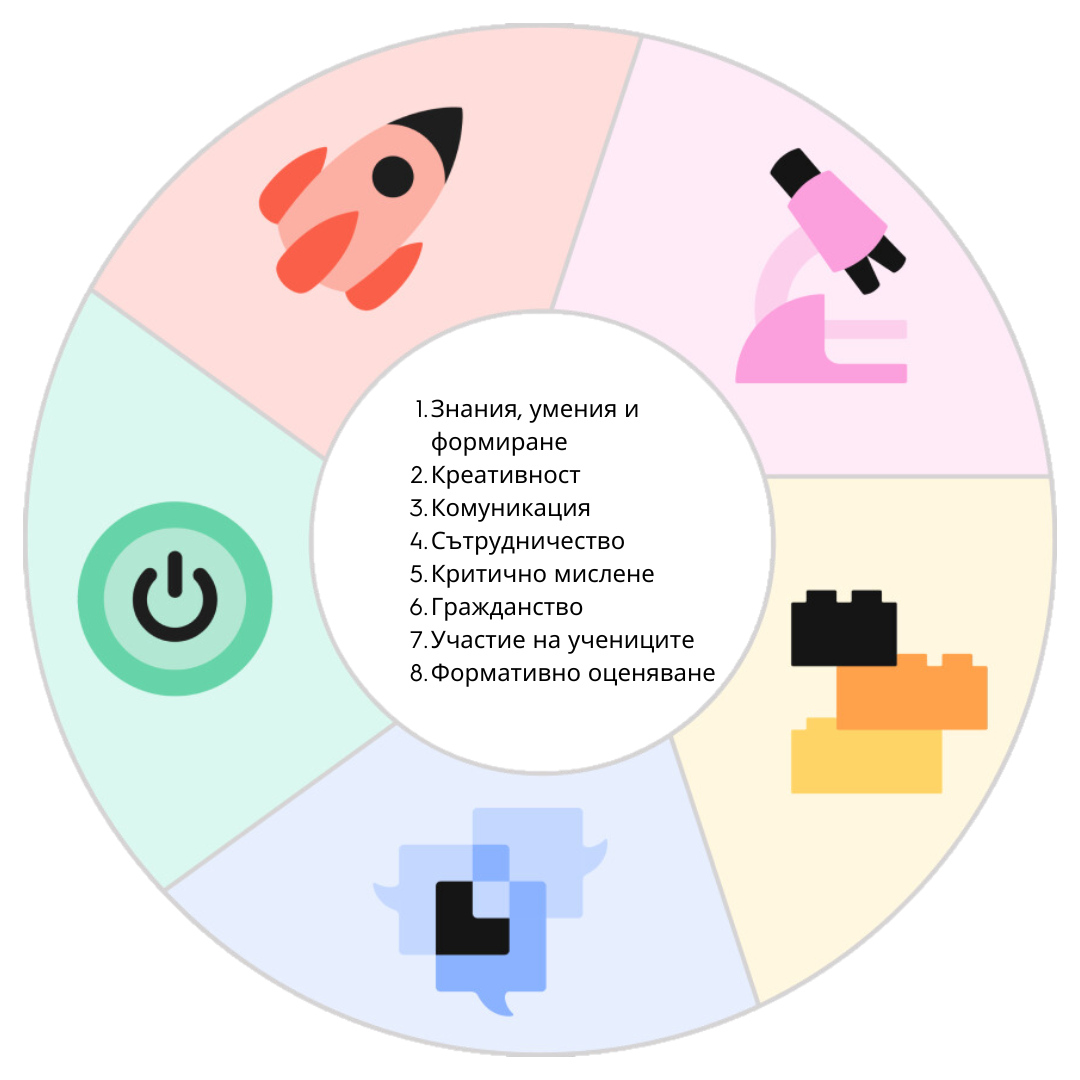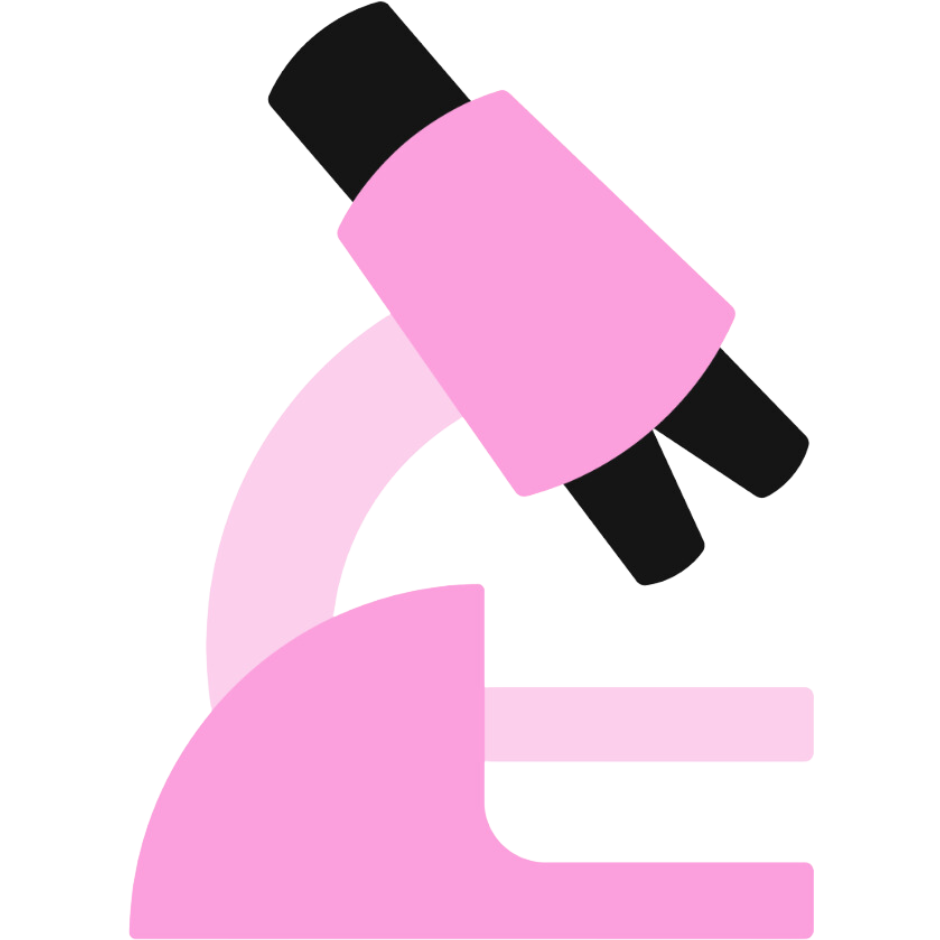

Цел:
Събудете интереса и желанието за учене за предстоящата работа.
Въпрос:
“Какво ви идва на ум, когато чуете [тема] ?”
Занимания:
Очаквана реакция:
“Това беше вълнуващо. Искам да науча повече!”

Цел:
Развийте умения за участие, за да могат учениците да правят информирани избори.
Въпрос:
“Кои аспекти на темата ви се струват най-интересни? Нека ги разгледаме заедно.”
Занимания:
Очаквана реакция:
“Сега имам обща представа за темата и знам върху какво искам да работя по-нататък!”

Цел:
Научете повече за специфични аспекти на темата, подготвяйки се за фазата на онагледяване.
Въпрос:
“Как ще научим повече за това?”
Занимания:
Очаквана реакция:
“Сега знам достатъчно, за да създам нещо конкретно, чрез което мога да демонстрирам уменията си!”

Цел:
Дайте възможност на учениците да демонстрират знания и умения според собствените си условия.
Въпрос:
“Какво можете да създадете или направите, за да демонстрирате наученото?”
Занимания:
Очаквана реакция:
“Гордея се с работата си и съм готов да я представя.”

Цел:
Извлечете поуки от процеса чрез рефлексия.
Въпрос:
“Какво постигнахте, какъв беше мисловният ви процес и какви изводи си направихте?”
Занимания:
Очаквана реакция:
“Научих много и знам какво мога да направя по-добре следващия път.”


Планирането на учебни блокове в Mylab е проектирано да бъде гъвкаво, съобразено с нуждите. Един блок може да продължи от няколко дни до няколко месеца. Тази гъвкавост се дължи, както на възможността за интердисциплинарно сътрудничество чрез покана на други преподаватели, така и на двете основни организационни нива при планирането:
Съвети за планиране:

Адаптиран модел на дидактически връзки:
За конкретно планиране можете да използвате модел на дидактически връзки, който взема предвид фактори, основани на ценности и принципи, както и специфични елементи в етапа на планиране.

Задачи с висока стойност:
Задачите с висока стойност се отнасят за учебни дейности, които предоставят на учениците възможност да изследват сложни концепции и да прилагат знания и умения в различни дисциплини. Те са създадени да бъдат отворени и двусмислени, като поощряват критично мислене и решаване на проблеми. Ето някои ключови характеристики на задачите с висока стойност:
В Learnlab вярваме в ролята на задачи с висока стойност като приобщаващ метод, така че всички ученици да могат лесно да започнат и да разберат задачите. Ние предоставяме разнообразни инструменти, които насърчават творческо учене – както индивидуално, така и в сътрудничество с другите. Тези инструменти са съобразени и с конкретни потребности, като например езикови адаптации.
За размисъл:
Как може AI да допринесе?


Разумно е учебният процес да започне с разпалване на любопитството и мотивацията у учащите. Тази начална фаза е от съществено значение за оползотворяване на вроденото любопитство на учениците и използване на съществуващата им база от знания. Основната цел е да се създаде усещане за значимост и стремеж към учене, които да стимулират последващата работа.
 Colab е перфектен за събуждане на любопитство и активиране на предишни знания, като улеснява участието чрез отворени задачи, облаци от думи, анкети и стъпка по стъпка напредване.
Colab е перфектен за събуждане на любопитство и активиране на предишни знания, като улеснява участието чрез отворени задачи, облаци от думи, анкети и стъпка по стъпка напредване.
 Idealab може да се използва чрез създаване на споделена мисловна карта, в която се събира информация по съответната тема, концепция или термин. В края на периода мисловната карта може да се обнови с различен цвят, за да покаже каква нова информация е научена.
Idealab може да се използва чрез създаване на споделена мисловна карта, в която се събира информация по съответната тема, концепция или термин. В края на периода мисловната карта може да се обнови с различен цвят, за да покаже каква нова информация е научена.
Storylab е подходящ инструмент, например за упражнение по щафетно писане. Нека учениците запишат всичко, което си спомнят по темата, за 1-2 минути, след което разменят материалите си и допълнят текста на своя партньор.
 Помолете учениците да създадат кратък видео- или аудиоклип, в който споделят всичко, което си спомнят по темата. Те могат да влязат в роли, например на репортери или журналисти, които се интервюират взаимно.
Помолете учениците да създадат кратък видео- или аудиоклип, в който споделят всичко, което си спомнят по темата. Те могат да влязат в роли, например на репортери или журналисти, които се интервюират взаимно.
За размисъл:
Как може AI да допринесе?
 Learny може да обобщи въведените от учениците данни в Colab, да подчертае разнообразието в мисленето им и да създаде въпроси за размисъл въз основа на учебните цели и ключовите концепции, предварително добавени от учителя.
Learny може да обобщи въведените от учениците данни в Colab, да подчертае разнообразието в мисленето им и да създаде въпроси за размисъл въз основа на учебните цели и ключовите концепции, предварително добавени от учителя.
.
 Тази фаза е насочена към предоставяне на учениците обща представа за темата, за да могат да направят информиран избор относно областите, в които искат да се задълбочат. Това е фаза, която често се пренебрегва. Често се стремим към различни форми на ученическо участие, което изисква от нас да развиваме уменията за ангажираност на учениците и да укрепваме тяхната идентичност, интереси и мотивация. Това се постига чрез предоставяне на възможности за ориентиране и взаимодействие с темата по начин, който съответства на индивидуалния им стил на учене и предпочитания.
Тази фаза е насочена към предоставяне на учениците обща представа за темата, за да могат да направят информиран избор относно областите, в които искат да се задълбочат. Това е фаза, която често се пренебрегва. Често се стремим към различни форми на ученическо участие, което изисква от нас да развиваме уменията за ангажираност на учениците и да укрепваме тяхната идентичност, интереси и мотивация. Това се постига чрез предоставяне на възможности за ориентиране и взаимодействие с темата по начин, който съответства на индивидуалния им стил на учене и предпочитания.
Colab може да бъде използван като банка от ресурси, като се добавят линкове, видеа и съдържание, които учениците да изследват директно в приложението. Учениците могат да допринесат със свои предложения за качествени източници в отворените задачи. Това е отлична възможност за упражняване на критично мислене относно източниците.
Idealab може да се използва като банка с ресурси, включваща линкове, видеоклипове, документи и аудиофайлове. Учениците могат съвместно да създават мисловна карта, да споделят интересна информация, която намерят, и да я категоризират заедно.
Storylab може да се използва като ресурсна банка с различни връзки, видеа, аудио файлове и съдържание. Учителят може да копира материали от библиотеката за учениците да ги изучават или да създават съдържание сами. Учениците могат да използват интерактивния четец, за да бъде текстът прочетен на глас или преведен на множество езици.
Преподавателят може да разработи подкасти или видеоматериали, или да споделя такива от библиотеката, които самостоятелно да изучават учениците.
За размисъл:
Как може AI да допринесе?
 Learny може да обобщава мисловните карти или мултимодални книги, които учителят иска учениците да проучат в Idealab и Storylab. За някои това може да е начин за адаптиране на нивото на трудност, тъй като обобщението може да бъде прочетено на глас и преведено на различни езици.
Learny може да обобщава мисловните карти или мултимодални книги, които учителят иска учениците да проучат в Idealab и Storylab. За някои това може да е начин за адаптиране на нивото на трудност, тъй като обобщението може да бъде прочетено на глас и преведено на различни езици.
 Задълбочаването позволява обстойно разбиране на ключови знания, умения и аспекти на личностното развитие, които се считат за важни през този период. В тази фаза учениците се насочват към задълбочено изследване на специфични аспекти на темата, за да усвоят ключови концепции и идеи, като по този начин се насърчава дълбоко и нюансирано разбиране на съдържанието. Това е също възможност за придобиване на нови стратегии за учене, методи на работа и умения.
Задълбочаването позволява обстойно разбиране на ключови знания, умения и аспекти на личностното развитие, които се считат за важни през този период. В тази фаза учениците се насочват към задълбочено изследване на специфични аспекти на темата, за да усвоят ключови концепции и идеи, като по този начин се насърчава дълбоко и нюансирано разбиране на съдържанието. Това е също възможност за придобиване на нови стратегии за учене, методи на работа и умения.
Colab може да бъде използван от учениците за проверка на разбирането чрез тестове или съчетаване на стъпки. Възможно е също така да поканят външни специалисти и да проведат дискусия с рефлективен елемент или интервю с тях, синхронно или асинхронно, посредством интерактивните стъпки.
 Idealab може да се използва за задълбочени изследвания, при които учениците – индивидуално или в групи – създават мисловна карта, основана на наученото в процеса. Тук те могат постепенно да изграждат, подреждат в категории и визуализират своите все по-задълбочени знания
Idealab може да се използва за задълбочени изследвания, при които учениците – индивидуално или в групи – създават мисловна карта, основана на наученото в процеса. Тук те могат постепенно да изграждат, подреждат в категории и визуализират своите все по-задълбочени знания
 Storylab може да се използва за четене на мултимодални текстове от библиотеката или създадени от учителя. Учениците също могат да водят записки или да създават аудио- или видео-дневници за това, което учат.
Storylab може да се използва за четене на мултимодални текстове от библиотеката или създадени от учителя. Учениците също могат да водят записки или да създават аудио- или видео-дневници за това, което учат.
 Учениците могат да разглеждат видеоклипове или подкасти от библиотеката, както и такива, създадени от учителя. Освен това, те могат да създават аудио- или видео-дневници, за да документират наученото в процеса.
Учениците могат да разглеждат видеоклипове или подкасти от библиотеката, както и такива, създадени от учителя. Освен това, те могат да създават аудио- или видео-дневници, за да документират наученото в процеса.
За размисъл:
Как може AI да допринесе?
 Learny може да създава стимулиращи въпроси в Idealab и Storylab въз основа на планирането на учителя, като помага на учениците да се задълбочат в темата.
Learny може да създава стимулиращи въпроси в Idealab и Storylab въз основа на планирането на учителя, като помага на учениците да се задълбочат в темата.

Сега е време учениците да създадат креативни и ангажиращи задачи и дейности, които им позволяват да демонстрират своята компетентност, базирана на индивидуалните им възможности. Чрез онагледяване те могат практически да покажат знанията (като концептуално разбиране), уменията и аспектите на личностното развитие, които са придобили през периода. Те трябва по някакъв начин да демонстрират повишената си осведоменост чрез думи, дейности и действия. Тази фаза е от ключово значение за това учениците да приложат теоретичните знания в практически и осезаеми форми.
Учениците могат да създават интерактивни презентации, които правят представянето по-завладяващо и образователно за аудиторията.
Idealab може да се използва за генериране на идеи или като ресурсна база, предназначена за презентиране. Учащите получават подкрепа в процеса на обучение чрез формативно оценяване от AI-асистента, Learny.
Storylab може да се използва като платформа за демонстриране на умения, като учениците създават мултимодален продукт с текст, изображения, видеоклипове, аудиофайлове, рисунки и други. Учениците могат да получат помощ от AI асистента Learny, за да усъвършенстват продукта чрез формативна оценка. Storylab е изключително подходящ инструмент за дигитализиране на аналогови процеси на обучение, като например училищни проекти на открито. Продуктите могат да бъдат представени дигитално или разпечатани и изложени на стена.
Учениците могат да създават завладяващи подкасти или видеоклипове. Те могат да включват въображаеми истории, обяснителни видеа, новинарски репортажи или дигитализация на обучения за практически умения.
За размисъл:
Как може AI да допринесе?
 В Storylab и Idealab Learny може да предоставя формативна обратна връзка върху работата на учениците, което освобождава време за вас като учител да се фокусирате върху изграждането на взаимоотношения в класната стая.
В Storylab и Idealab Learny може да предоставя формативна обратна връзка върху работата на учениците, което освобождава време за вас като учител да се фокусирате върху изграждането на взаимоотношения в класната стая.
Прогресивната педагогика в Learnlab включва обучение, ориентирано към учащите, при което учениците усвояват знания чрез действия и създаване, съобразено с техните индивидуални нужди, с възможност за творческа изява и активно участие, както и чрез рефлектиране върху учебния процес. Този подход черпи вдъхновение от теориите на изтъкнати педагози и психолози като Джон Дюи, Лев Виготски, Мария Монтесори, Лудвиг Витгенщайн, Хауърд Гарднър и Майкъл Фулан. Тези теории насърчават образователна система, която цени практическото обучение, критичното мислене и рефлексията—основни принципи, заложени в педагогическото съдържание и технологичните разработки на платформата Learnlab. Learnlab се стреми да създаде среда, в която ученето не само информира, но и трансформира, като насърчава личностното развитие и активния принос към обществото.
Джон Дюи: Обучение чрез опит и рефлективно мислене:
Джон Дюи, философ и образователен реформатор, отстоява за образование, основано на опита, като подчертава, че ученето се случва чрез преживявания и размисъл върху тях. Според Дюи образованието трябва да подготвя учениците за пълноценно взаимодействие с обществото и околната среда, като насърчава непрекъснат процес на дейности и осмисляне, който стимулира както личностното, така и интелектуалното им развитие. Learnlab предлага дигитални инструменти, които подпомагат размисъл и ученическо творчество. Colab е изключително подходящ за насърчаване на размишления, докато Storylab, Idealab и Medialab служат като отлични инструменти за ученически проекти и изяви. В допълнение, AI асистентът Learny е разработен, за да подпомага учениците в анализа на постигнатото и планирането на следващите им стъпки. За подхода „учене чрез правене“ препоръчваме комбинирането на нашата платформа с традиционни ученически дейности, за да се използват предимствата на обучението, основано на опита, креативните проекти и обмислена рефлексия.
Приложение в реалния свят: Идеята на Дюи, че образованието трябва да бъде тясно обвързано с опита от реалния свят, е основополагащ принцип в подхода на Learnlab. Учителите се насърчават да създават смислени/ щателно подготвени/ обогатени задачи, които ангажират учениците с местната среда и им дават възможност да представят своите проекти на по-широка аудитория извън рамките на класа.
Лев Виготски: Посредничество в ученето, зона на близко развитие и насочване/подпомагане
Лев Виготски, ключова фигура в психологията и образованието, полага основите на редица фундаментални концепции, оказали значително влияние върху съвременните педагогически практики. В центъра на неговата теория стои идеята за посредничество в ученето, която постулира, че ученето се осъществява чрез взаимодействие със социалната среда посредством инструменти и език. Това взаимодействие често се случва в рамките на „зоната на близко развитие“ (ЗБР) – разликата между това, което учащият може да постигне самостоятелно, и това, което може да постигне с насочване/подпомагане. Learnlab създава условия за социално учене с посредничество , при което учениците получават подкрепа (скеле) чрез технологии, като езикът, колаборативното обучение и изкуственият интелект са от централно значение.
Мария Монтесори: Фокус върху самонасоченото, практическо обучение (и „мира“)
Мария Монтесори революционизира ранното детско образование чрез въвеждането на подход, ориентиран към детето, който акцентира върху практическо, самонасочено учене във внимателно подготвена среда. Нейната философия се основава на убеждението, че децата усвояват знания най-ефективно, когато имат свободата да изследват материали и концепции със собствено темпо, водени от вътрешна мотивация, а не от външни стимули или натиск. Разнообразните инструменти на Learnlab, като Idealab, Storylab и Medialab, подкрепят такова изследване чрез взаимодействие както с традиционни, така и с дигитални източници. Фокусът на Монтесори върху „мира“ в широк смисъл е аспект, който Learnlab подкрепя чрез създаването на съдържание, което насърчава социално ангажирани граждани, стремящи се към вътрешен и външен мир. За сетивно базирано и активно обучение препоръчваме комбиниране на нашата платформа с обучение, основано на опита, в реална среда. Нашият обучителен асистент Learny подпомага учениците в самонасочения процес на учене, като предоставя подкрепа при нужда и позволява на учителите да насочват усилията си там, където е най-необходимо.
Лудвиг Витгенщайн: Философия на езика и ученето
Лудвиг Витгенщайн, водеща фигура в съвременната философия, оказва значително влияние върху разбирането на езика и неговата роля в ученето. Той подчертава, че значението на думите зависи от контекста, а езикът придобива смисъл чрез употребата си в различни „форми на живот“. Концепциите се осмислят напълно, едва когато бъдат приложени на практика. Затова ние се фокусираме върху това учениците да конкретизират своето учене чрез действия и създаване, които служат за основа при демонстрация на умения. Тази перспектива поставя акцент върху практическото приложение на езика в конкретни дейности и общности, подчертавайки важността на контекста за ефективната комуникация и разбирането. AI асистентът на LearnLab, Learny, е създаден, за да подпомага учениците в целенасоченото използване на езика, основано на образователните цели и ключовите концепции, зададени от учителя за съответната тема.
Хауърд Гарднър: Теория за множеството интелигентности
Теорията за множеството интелигентности на Хауърд Гарднър оказва съществено влияние върху образователната философия, като предлага, че интелигентността не е единна обща способност, а се състои от различни измерения. Според Гарднър образованието трябва да бъде съобразено с индивидуалните силни страни и стилове на учене на учениците, за да се максимизира техният потенциал.
Платформата LearnLab постига изключителен успех в развиването на учениците в ключови области като лингвистична, логико-математическа, интерперсонална и интраперсонална интелигентност, както и критично мислене. Развитието на останалите типове интелигентност зависи от дейностите, които учителят включва в своя план. Традиционните дейности могат лесно да се интегрират с дигиталните активности, предлагани от платформата LearnLab.
Майкъл Фулан: Задълбочено обучение
Майкъл Фулан, известен изследовател в сферата на образованието и най-вече със своите идеи за задълбоченото обучене, е основно вдъхновение за норвежката учебна програма LK-20. Фулан идентифицира шест ключови компетентности, които са жизненоважни за учениците в 21-ви век:
Харгрийвс и Шърли: Ангажираност на учениците
Денис Шърли и Анди Харгрийвс подчертават необходимостта от по-добър баланс между представянето/резултатите и благополучието в училищата. Те идентифицират пет пътя, които насърчават, и пет, които възпрепятстват ангажираността на учениците. Пречките включват неудовлетвореност, откъснатост от училището и учебната програма, отчуждение от обществените норми, лишаване на възможности и разсейване. За да се насърчи ангажираността на учениците, фокусът трябва да бъде върху овладяването на знания, засилване на увереността, присъщата стойност на учебната дейност, разбирането на важността на това, което се учи, и свързването на ученето с културата, от която е част ученикът.
Дигиталните инструменти могат да засилят ангажираността на учениците, когато се използват с ясни цели и намерения, докато стандартните тестове често се възприемат като основен враг на ученическата ангажираност. В Learnlab работим за въвеждане на обучение, базирано на тематични периоди, което насърчава значимостта, овладяването на знания и активното участие на учениците, възприемайки подход, фокусиран върху портфолио. Това досега представляваше предизвикателство за учителите, но с помощта на AI тази задача става значително по-лесна. Предлагаме учебни ресурси, които учителите могат да копират и адаптират спрямо местните условия. Освен това имаме силен акцент върху съдържание, свързано със саамската култура, което подпомага език и култура, намиращи се под голям натиск.